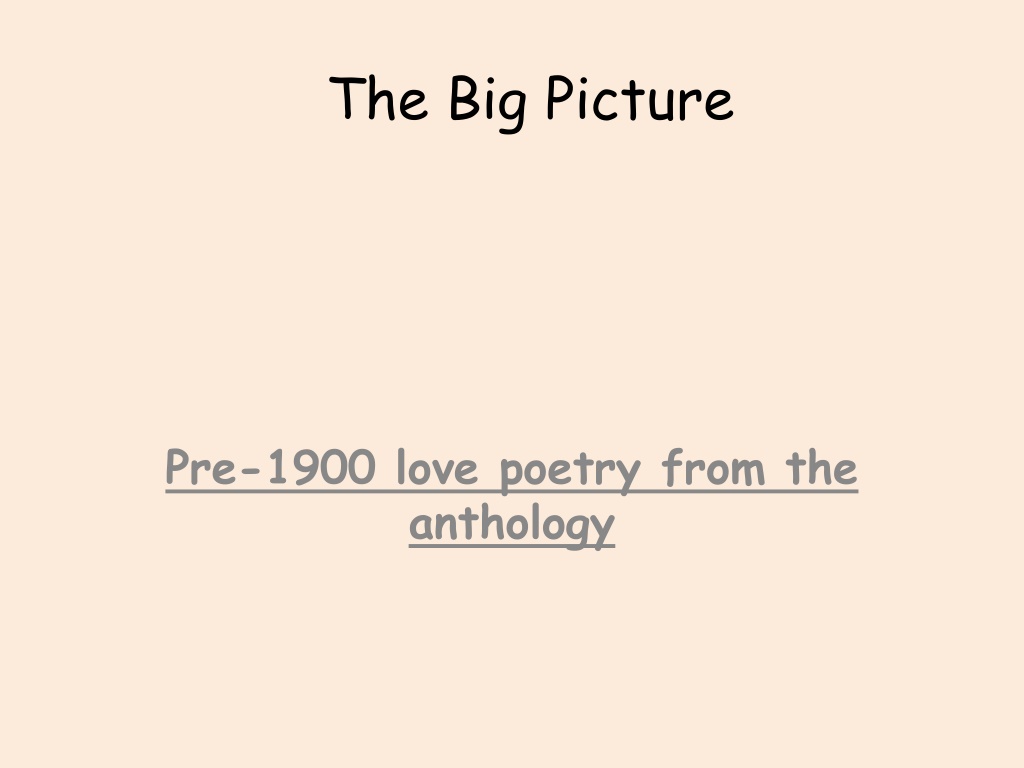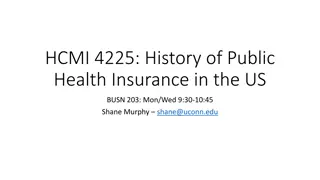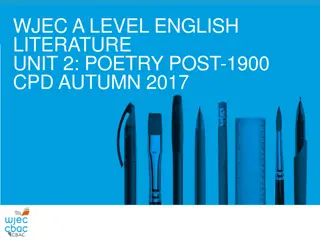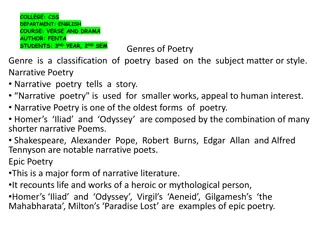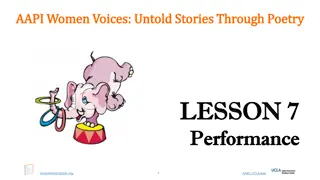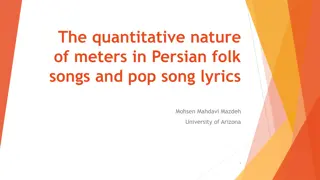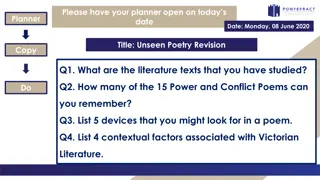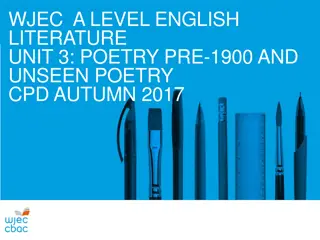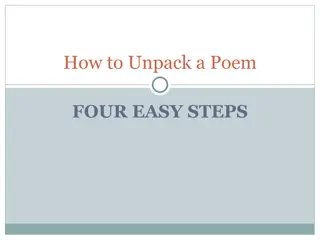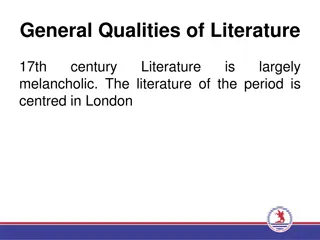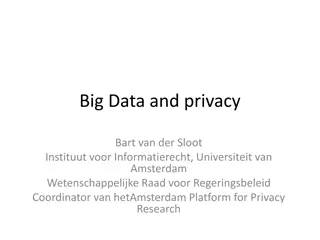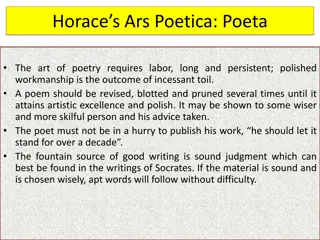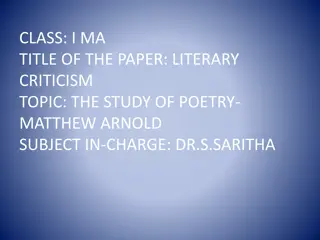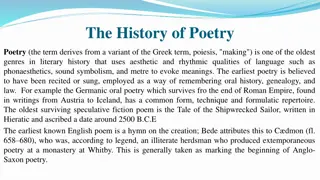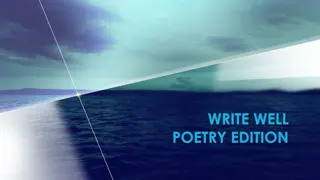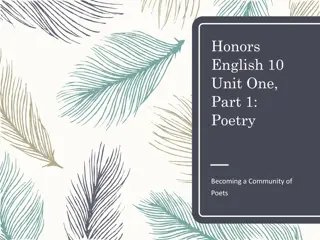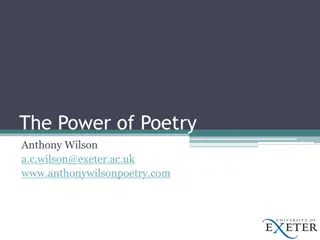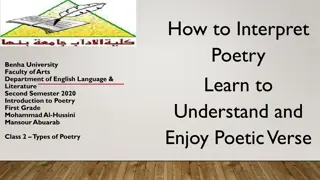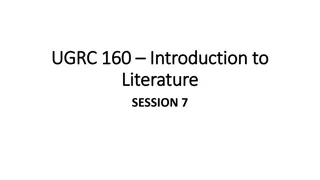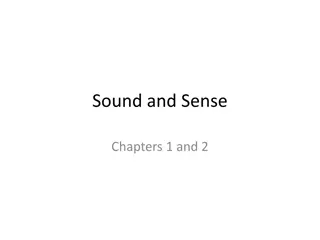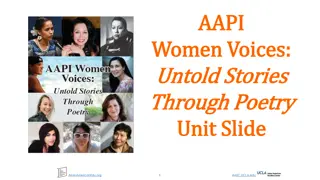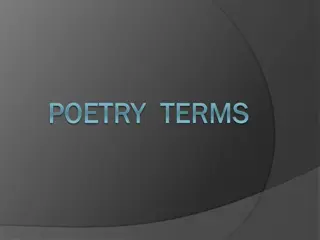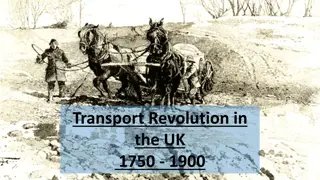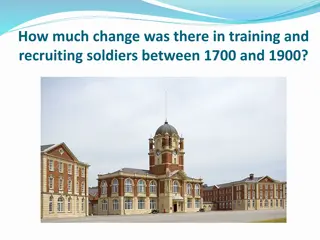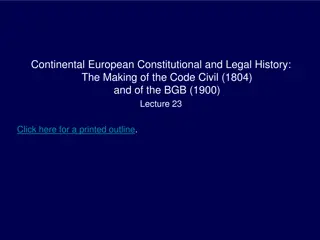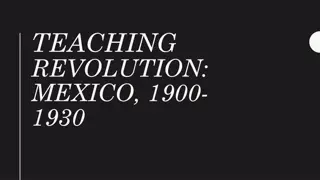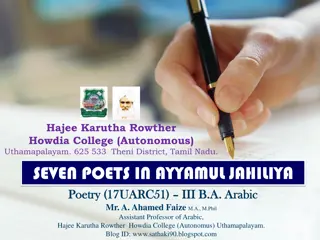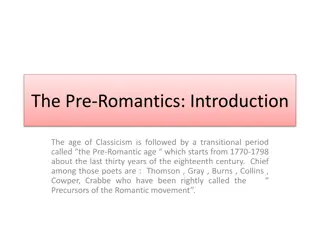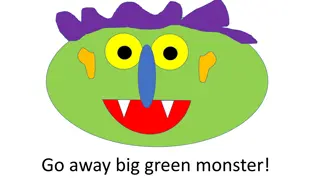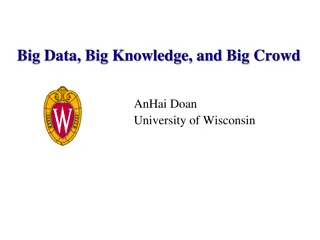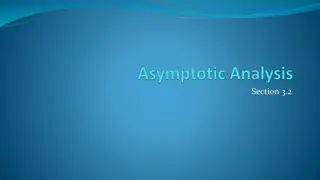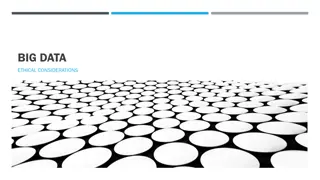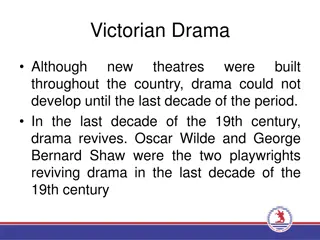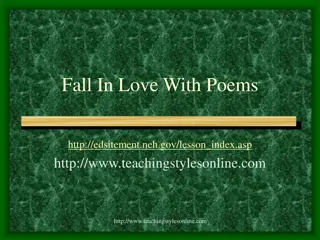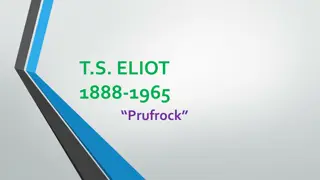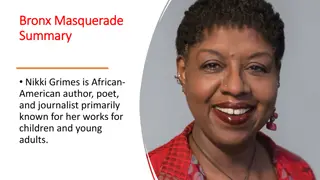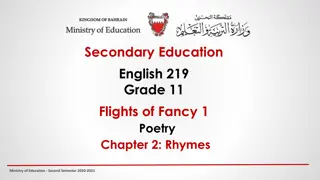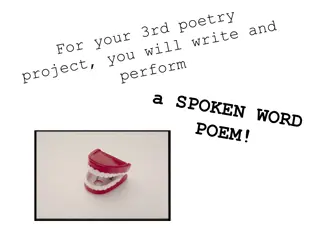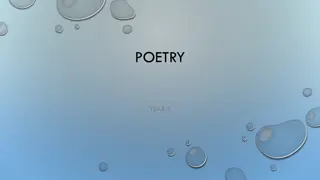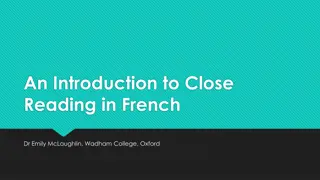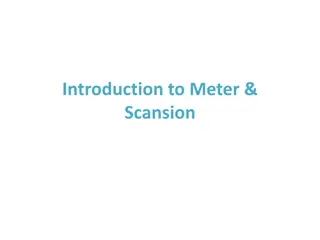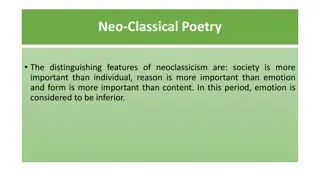Pre-1900 Love Poetry: The Big Picture
Explore the world of love poetry before 1900 through the lens of John Wilmot, Earl of Rochester. Delve into his life, works, and influence, reflecting the poetic trends of the era. Uncover the complexities of love, society, and expression in historical context, preparing to analyze and appreciate the nuances of his poetry.
Download Presentation

Please find below an Image/Link to download the presentation.
The content on the website is provided AS IS for your information and personal use only. It may not be sold, licensed, or shared on other websites without obtaining consent from the author. Download presentation by click this link. If you encounter any issues during the download, it is possible that the publisher has removed the file from their server.
E N D
Presentation Transcript
The Big Picture Pre-1900 love poetry from the anthology
The Big Picture Poetry = Section B of Paper 2 45 minutes The poem is provided 1 question
John Wilmot A Song (Absent from thee) L.O to understand the context of the poem To develop analysis of the poem To be able to plan for an essay To be able to write the essay
Success Criteria To be successful, you need to: Be able to see the typicality of the poem in relation to love poetry of that time and in general, e.g. restoration poetry being often a reaction to the puritan interregnum, to love and religion conventionally featuring in poetry Respond to the debate set up in the question (this does NOT mean that you have to argue both sides ) Write about form, structure and language but only about things you understand!! demonstrate an understanding of context in relation to the poem without bolting it on
John Wilmot, Earl of Rochester 1647 - 1680 Most people have heard of him through the Johnny Depp film, The Libertine
John Wilmot, Earl of Rochester He lived a fairly short life and was only 33 when he died. He was called the wickedest man in England .
John Wilmot, Earl of Rochester Part of Charles II s court restored to the throne in 1660 after the interregnum and following a period of puritan enforcement in England.
John Wilmot, Earl of Rochester Rochester was very close to the King and leader of the merry gang who were notorious for their outrageous public behaviour. He was a drunk and sexually very active.
John Wilmot, Earl of Rochester However, Marvell said of him that he had the true veine of satyre. He may have been a friend of the king but he also mocked him. Voltaire said that, Tout le monde connoit de reputation le Comte de Rochester. (Everyone knows the reputation of Rochester)
John Wilmot, Earl of Rochester He is considered the last and the best of the cavalier poets. He was clever, witty, handsome but financially secure. He abducted an heiress (who he actually went on to marry).
John Wilmot, Earl of Rochester While his work is often judged as pornographic (though there must be questions of the authenticity of some work), he is also often considered a great love poet .
John Wilmot Earl of Rochester Song Remember - Cavalier poets tended to: Write to praise a friend/fellow poet Give advice in grief or love Define a relationship Articulate the amount of attention a man owes a woman To celebrate beauty To persuade to love
To His Coy Mistress Absent from thee I languish still, Then ask me not, when I return? The straying Fool twill plainly kill, To wish all Day, all Night to Mourn. Dear, from thine Arms then let me flie, That my Fantastick mind may prove, The Torments it deserves to try, That tears my fixt Heart from my Love. When wearied with a world of Woe, To thy safe Bosom I retire Where Love and Peace and Truth does flow, May I contented there expire. Lest once more wandring from that Heav n I fall on some base heart unblest; Faithless to thee, False, unforgiv n, And lose my Everlasting rest.
Song.. Now consider the form/structure: It s a standard form for a Restoration song 2. In iambic tetrameter in quatrains which are rhymed ABAB 3. Quite a simple form typical of a song 1.
Song. The audience would be mostly male, aristocratic and part of the king s court. Would modern audiences read this poem differently? Might we be offended or shocked? Is there sincerity here or not?
Song Iambic tetrameter? Remember it from other poems? How is this maths minded? You re exploring patterns; this is maths minded
Song Iambic tetrameter? Break it down tetra?
Song. Remember - an iambic foot is a pair of syllables where the first one is unstressed, the second stressed. Tetrameter means there are 4 iambic feet in each line
Song. How many syllables in a line of iambic pentameter? How many syllables in a line of iambic tetrameter?
Song. Identify the iambic tetrameter in the poem. What is the effect of using this rhythm? AO2 Think of analysing the writer s methods really important!
Analysis Probably written during the restoration Cavalier poem Self-interested love? Selfish love? Sexual love? Sincere?
Analysis A Song (Absent from thee) This is an erotic poem in places with also elements of religious language. Would it shock an audience to hear the two together? When away from the addressee, the speaker languish[es] First person speaker no voice from the addressee Language can feel a bit clich d and almost hymn like Absent from thee I languish still, Then ask me not, when I return? The straying Fool twill plainly kill, To wish all Day, all Night to Mourn. Suggests that he has strayed or been unfaithful It would be harmful to keep longing
Analysis Dear is italicised - for emphasis? Must leave her arms Dear, from thine Arms then let me flie, That my Fantastick mind may prove, The Torments it deserves to try, That tears my fixt Heart from my Love. This is a strange one fantastic suggests some fantasies disturbing as we wonder what fantasies. Similar to The Scrutiny suggesting that he is forced by some compulsion to leave the woman he loves. Torments it deserves to try is this sado- masochism? What kind of love is this? tears = violence
Analysis Religious? The bosom of Christ/God? However, he was not religious and often made fun of this .do we take him seriously, especially when coupled with the excessive alliteration in line 1. Alliteration to excess here start to question is he mocking? Like the holy trinity again bringing religion in When wearied with a world of Woe, To thy safe Bosom I retire Where Love and Peace and Truth does flow, May I contented there expire. Die in her arms against bosom very religious or again excessive
Analysis The metaphor of heaven applied to her base means awful, lowest Lest once more wandring from that Heav n I fall on some base heart unblest; Faithless to thee, False, unforgiv n, And lose my Everlasting rest. Fricatives used here but to emphasise what? His faithlessness of the previous line will result in his losing heaven/her.
Types of love Selfish? Sexual? Light-hearted? Free? mocking? Lust?
Question Examine the view that Wilmot presents the speaker in this poem as having a lustful attitude towards love. Discuss the question on your tables and consider how you would respond.! Make notes
Absent from thee Exit Pass Tell each other 3 things you have learned today
